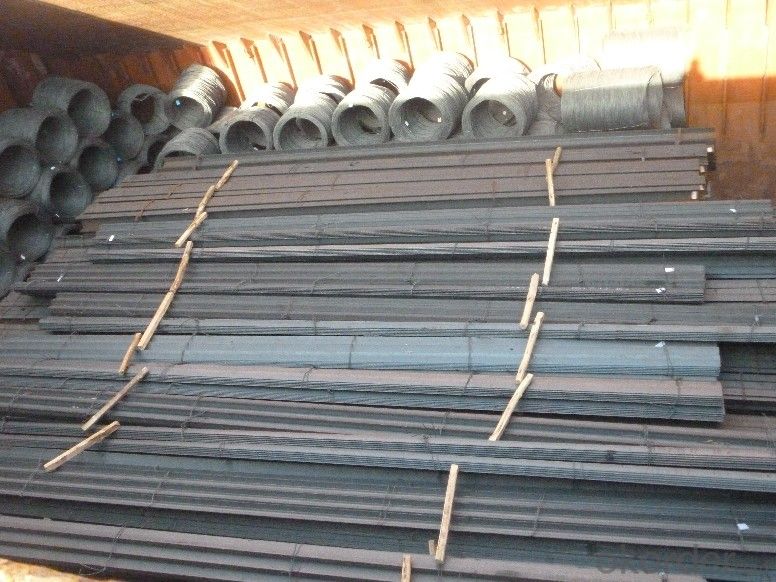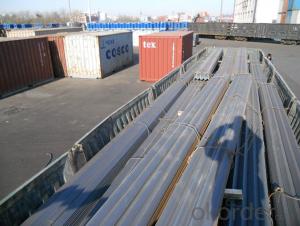Steel Angle Equal Angle with High Quality for Construction
- Loading Port:
- Tianjin
- Payment Terms:
- TT OR LC
- Min Order Qty:
- 25 m.t.
- Supply Capability:
- 20000 m.t./month
OKorder Service Pledge
OKorder Financial Service
You Might Also Like
Item specifice
Product Description:
OKorder is offering Steel Angle Equal Angle with High Quality for Construction at great prices with worldwide shipping. Our supplier is a world-class manufacturer of steel, with our products utilized the world over. OKorder annually supplies products to European, North American and Asian markets. We provide quotations within 24 hours of receiving an inquiry and guarantee competitive prices.
Product Applications:
Steel Angle Equal Angle with High Quality for Construction are ideal for structural applications and are widely used in the construction of buildings and bridges, and the manufacturing, petrochemical, and transportation industries.
Product Advantages:
OKorder's Steel Angle Equal Angle with High Quality for Construction are durable, strong, and resist corrosion.
Main Product Features:
· Premium quality
· Prompt delivery & seaworthy packing (30 days after receiving deposit)
· Corrosion resistance
· Can be recycled and reused
· Mill test certification
· Professional Service
· Competitive pricing
Packaging & Delivery of Steel Angle Equal Angle with High Quality for Construction:
Packaging Detail: products are packed in bundle and then shipped by container or bulk vessel, deformed bar is usually naked strapping delivery, when storing, please pay attention to moisture proof. The performance of rust will produce adverse effect.
Each bundle weight: 2-3MT, or as required
Payment term: TT or L/C
Delivery Detail: within 45 days after received advanced payment or LC.
Label: to be specified by customer, generally, each bundle has 1-2 labels
Trade terms: FOB, CFR, CIF
Images:


- Q:How do steel angles compare to other structural materials, such as wood or concrete?
- Steel angles are known for their high strength-to-weight ratio, making them more durable and capable of supporting heavier loads compared to wood or concrete. Additionally, steel angles are resistant to fire, termites, and rot, which are common concerns with wood. While concrete is strong, it is more brittle and can crack under tension, whereas steel angles have better flexibility and can absorb more impact. Overall, steel angles are a preferred choice for structural applications due to their superior strength, durability, and versatility.
- Q:Can steel angles be used for signposts?
- Yes, steel angles can be used for signposts. Steel angles are commonly used in a variety of structural applications, including signposts. They are strong, durable, and provide excellent support for signs. Steel angles can be easily welded or bolted together to form a sturdy and reliable signpost. Additionally, steel angles are resistant to weather and can withstand harsh environmental conditions, making them suitable for outdoor use. Overall, steel angles are a popular choice for signposts due to their strength, durability, and versatility.
- Q:I would like to ask you, angle iron, what does it usually use ah?
- Mainly used for making steel frame structure, such as high-voltage transmission tower, steel structure bridge on both sides of the frame, the construction site of the tower crane arm, workshop columns and columns and beams, small holiday places such as roadside stands, the window in the other pot under the air conditioning solar rack etc..
- Q:What are the different types of connections used for steel angles in industrial settings?
- There are various types of connections used for steel angles in industrial settings, including bolted connections, welded connections, and riveted connections. These connections provide structural support and stability to steel angles, ensuring their integrity and strength in industrial applications.
- Q:Can steel angles be used for retaining walls?
- Yes, steel angles can be used for retaining walls. Steel angles are commonly used in construction for various purposes, including supporting structures and creating retaining walls. They provide strength and stability to the wall, making them suitable for retaining soil or other materials. Steel angles can be used as a primary structural element or in combination with other materials, such as concrete or timber, to form a robust and durable retaining wall. The specific design and engineering considerations would depend on factors such as the height and load requirements of the wall, as well as the soil conditions and local building codes. However, with proper design and installation, steel angles can be an effective choice for retaining walls.
- Q:How do you determine the required size of a steel angle for a specific application?
- There are several factors to consider when determining the necessary size of a steel angle for a particular application. These factors include the load or weight the angle will support, the distance between supports, and the material properties of the steel angle. The first step is to determine the load or weight that the angle will bear. This can be done by calculating the total load applied to the angle, including any objects or structures it will support. It is important to account for static and dynamic loads, as well as potential impact or wind loads. Next, the distance between supports must be taken into account. This is the length over which the angle will span and bear the load. Longer spans typically require larger and stronger angles to maintain structural integrity. Furthermore, the material properties of the steel angle are crucial in determining its necessary size. Steel angles come in different grades and strengths, each with varying load-bearing capacities. It is important to consult engineering and design codes, such as the AISC Manual, to determine the appropriate grade of steel angle that can withstand the calculated load. Once the load, span, and material properties are determined, engineering calculations can be performed to select the necessary size of the steel angle. These calculations typically involve evaluating the angle's moment, shear, and deflection under the applied load. Design tables and equations from the AISC Manual can be used to determine the appropriate size and shape of the angle based on these calculations. To conclude, determining the necessary size of a steel angle for a specific application involves considering the load, span, and material properties of the angle. By performing engineering calculations and referring to design codes, the appropriate size of the angle can be selected to ensure structural safety and integrity.
- Q:Can steel angles be drilled or punched for fastening?
- Yes, steel angles can be drilled or punched for fastening.
- Q:How do you clean steel angles?
- To clean steel angles, you can start by removing any loose dirt or debris with a soft brush or cloth. Then, mix a solution of mild detergent and warm water and use a sponge or cloth to gently scrub the surface. Rinse the angles thoroughly with clean water and dry them with a clean cloth to prevent any water spots or rusting.
- Q:Can steel angles be used for manufacturing furniture?
- Yes, steel angles can be used for manufacturing furniture. They provide structural support and can be used to create strong and durable furniture pieces. Steel angles are commonly used in industrial and modern furniture designs due to their sleek and minimalist aesthetic.
- Q:What is the maximum length for a steel angle?
- The maximum length of a steel angle can differ based on the angle's specific type and size, as well as the steel supplier's manufacturing capabilities. Typically, steel angles are offered in standard lengths spanning from 20 to 40 feet. However, longer lengths could be attainable via custom orders or specialized production methods. To ascertain the readily available or obtainable maximum length for a particular steel angle, it is advisable to seek guidance from a steel supplier or manufacturer.
1. Manufacturer Overview |
|
|---|---|
| Location | |
| Year Established | |
| Annual Output Value | |
| Main Markets | |
| Company Certifications | |
2. Manufacturer Certificates |
|
|---|---|
| a) Certification Name | |
| Range | |
| Reference | |
| Validity Period | |
3. Manufacturer Capability |
|
|---|---|
| a)Trade Capacity | |
| Nearest Port | |
| Export Percentage | |
| No.of Employees in Trade Department | |
| Language Spoken: | |
| b)Factory Information | |
| Factory Size: | |
| No. of Production Lines | |
| Contract Manufacturing | |
| Product Price Range | |
Send your message to us
Steel Angle Equal Angle with High Quality for Construction
- Loading Port:
- Tianjin
- Payment Terms:
- TT OR LC
- Min Order Qty:
- 25 m.t.
- Supply Capability:
- 20000 m.t./month
OKorder Service Pledge
OKorder Financial Service
Similar products
New products
Hot products
Related keywords




























